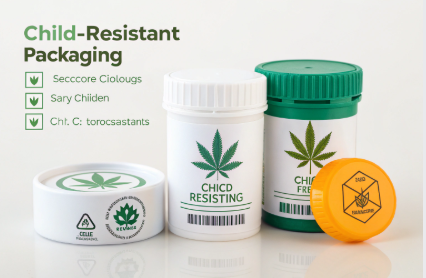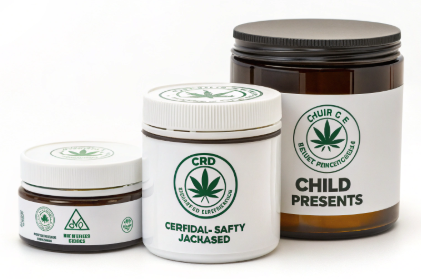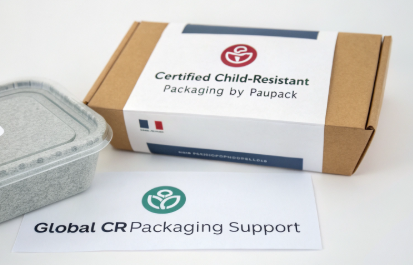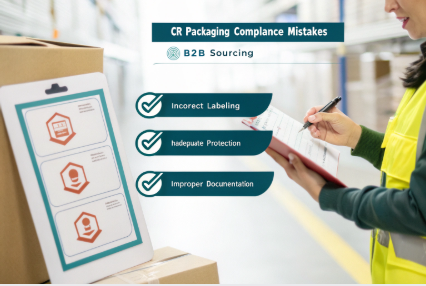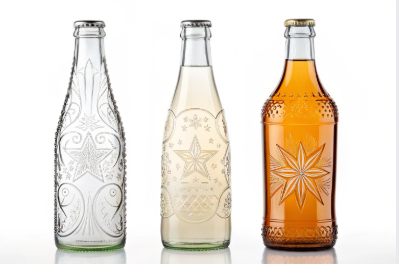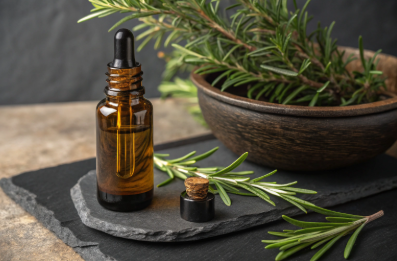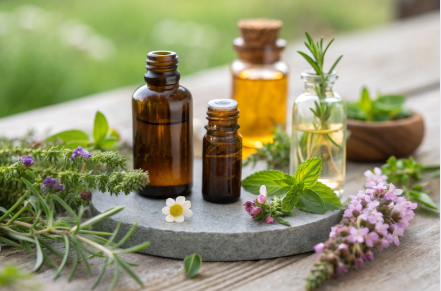One safety incident is all it takes to damage a brand’s reputation and invite costly legal trouble—especially in industries serving sensitive users like children.
Child-resistant (CR) packaging is a legal and moral obligation in many industries. B2B buyers must verify structural safety, certification documents, and testing standards before sourcing.
If you're sourcing containers for supplements, cannabis, personal care, or pharmaceuticals, this guide will walk you through the key compliance checkpoints.
What Is Child-Resistant Packaging and Why Is It Legally Required?
Child-resistant packaging isn’t just a marketing claim—it’s a regulatory mandate.
CR packaging is designed to prevent children under five from opening a product, reducing the risk of accidental ingestion, poisoning, or injury.
Legal Foundation of CR Packaging
Regulators in many countries require child-resistant packaging for products that could harm children if swallowed or misused. This includes:
-
Pharmaceuticals
-
Nutraceuticals
-
Cannabis
-
Household chemicals
-
CBD and essential oils
In the U.S., the Poison Prevention Packaging Act (PPPA) sets the federal standard, enforced by the Consumer Product Safety Commission (CPSC). EU markets follow EN 862 and ISO 8317 testing protocols.
At PauPack, we build packaging to meet PPPA, EN, and ISO standards, making our CR jars and closures suitable for regulated industries in North America and Europe.
Which Industries Must Use CR Packaging and What Are the Key Regulations?
It’s not just about medicine anymore—B2B buyers across wellness, cosmetics, and food packaging must now think CR.
Industries dealing with potentially harmful or high-potency substances are legally required to use CR packaging—often by both federal and state-level mandates.
CR Requirements by Industry
| Industry | Example Products | Key CR Regulation |
|---|---|---|
| Pharmaceuticals | OTC meds, prescriptions | PPPA, ISO 8317 |
| Cannabis / CBD | Gummies, oils, vapes | ASTM D3475, CPSC |
| Nutraceuticals | Supplements, capsules | PPPA |
| Essential Oils | Eucalyptus, tea tree | EU CLP, EN 862 |
| Cosmetics | Nail polish remover | ISO 8317 |
PauPack offers a wide range of compliant CR packaging solutions—from twist-lock jars to push-and-turn droppers—tested and certified for their intended product category.
How Can You Verify If a Package Is Truly Child-Resistant Certified?
Many suppliers “claim” child-resistance but fail to back it up with proper documentation.
To confirm compliance, buyers must request third-party lab test reports, certificates, and detailed test results showing pass rates under ISO or ASTM standards.
CR Verification Checklist
| Document / Feature | What to Check | Why It Matters |
|---|---|---|
| ISO/EN/ASTM Certs | Scope, batch number, lab stamp | Ensures legal compliance |
| Test Report Summary | Child panel success rate | Required >85% failure to open |
| Adult Panel Test | Ease of adult use | Ensures accessibility |
| Tamper Indicators | Visual cues | Extra protection for first use |
| Supplier Claims vs. Proof | Marketing vs. lab data | Prevent greenwashing or risk claims |
At PauPack, all CR products come with complete certification bundles. Our clients receive digital copies of ISO 8317 or EN 862 test results alongside batch samples.
What Structural Features Define an Effective CR Design?
A compliant CR design needs to be both safe and user-friendly—especially for seniors or differently abled adults.
Effective child-resistant packaging combines tactile resistance, dual-motion mechanics, and visual instructions to ensure safety without sacrificing usability.
Common CR Mechanisms in Packaging
| CR Feature | How It Works | Product Type |
|---|---|---|
| Push-and-Turn Cap | Simultaneous downward + rotation force | Medicine, oils |
| Squeeze-and-Turn | Requires dexterity to unlock | Tubes, vials |
| Button-Lock Lid | Push-button must be pressed while twisting | Cosmetics, candles |
| Lock-Ring Jar | Screw + pop-up tab | Cannabis, supplements |
| Hidden-Latch Box | Invisible release lever | Premium gift packaging |
We’ve helped clients redesign seemingly “safe” containers that still failed lab testing. A good CR supplier like PauPack doesn’t just provide the part—they provide the expertise and engineering to get it certified.
How PauPack Ensures Full CR Compliance for Global B2B Clients?
Compliance doesn’t happen by accident—it requires intentional design, third-party testing, and factory-level process control.
PauPack offers fully compliant, tested, and scalable child-resistant packaging options, with technical support to help brands avoid safety pitfalls.
What We Offer
-
Certified CR jars, caps, droppers, tubes, and boxes
-
ISO 8317 / EN 862 lab testing with documentation
-
Production with QC controls and serialized batch testing
-
Support for low MOQs and flexible shipping to North America, EU, and APAC
-
Custom decoration + branding for regulated products
Whether you're launching a new cannabis line or reformulating an essential oil SKU, our team walks you through the CR requirements—saving you time, cost, and legal exposure.
Are Global CR Packaging Standards the Same Across Regions?
A “certified” label in one country doesn’t guarantee compliance in another.
No, global CR packaging standards vary by region—U.S., EU, and Asia-Pacific each have distinct testing protocols, legal definitions, and labeling rules.
Regional Standard Overview
| Region | Certification Body | Test Method | Commonly Required For |
|---|---|---|---|
| United States | CPSC / PPPA | 16 CFR 1700.20 | Pharma, cannabis, supplements |
| European Union | EN ISO 8317 / EN 862 | ISO Panel Testing | Cosmetics, chemicals, essential oils |
| Canada | CCCR-2001 | Similar to CPSC | Cannabis, household items |
| Australia | TGA / NICNAS | ISO-compliant | Pharmaceuticals, toxic substances |
At PauPack, our child-resistant containers are designed and tested for ISO 8317, EN 862, and U.S. CPSC standards. We help brands build SKUs that can legally ship across borders.
What Are the Most Common Mistakes B2B Buyers Make with CR Compliance?
Don’t be fooled by packaging that “looks secure.” Compliance goes beyond good intentions.
The biggest mistakes include relying on supplier claims without documentation, skipping adult-use testing, and assuming one-size-fits-all certifications.
Top 5 CR Compliance Mistakes
-
No Lab Verification
Suppliers say “CR-compliant” but can’t show test results. -
Ignoring Local Law Nuances
Example: CBD oils need CR in the U.S., but not all EU countries yet. -
Overlooking Label Requirements
Some regions mandate visual indicators like warning text or icons. -
Assuming All CR Lids Fit All Jars
Torque resistance must be retested on new containers. -
Choosing Inflexible Designs
Mechanisms that frustrate adults or break easily under shelf wear.
PauPack not only provides CR-certified jars, caps, and dropper closures—we also advise on localized packaging law compliance to help our clients avoid costly relabeling or customs holds.
How to Audit Your CR Packaging Supplier Before You Buy?
Your packaging partner should be more than a vendor—they’re your compliance safeguard.
To audit CR suppliers, B2B buyers should inspect certifications, factory QC processes, testing history, and support for third-party validation.
CR Supplier Audit Checklist
| Audit Point | What to Ask | Red Flag |
|---|---|---|
| Certifications | Can you provide ISO 8317 or ASTM D3475 lab reports? | Vague answers or expired docs |
| Testing Partner | Who conducted the tests? (SGS, Intertek, etc.) | Unknown or internal-only testing |
| QC Process | Do you perform batch testing? | No batch logs or test samples |
| Prototyping Support | Can you simulate tests before tooling? | No CAD files or testing simulation |
| Client History | Who else do you serve in regulated markets? | No prior experience in pharma/CBD/skincare |
At PauPack, we support full compliance audits with our clients’ legal or sourcing teams. We offer pre-mass production prototyping and stress testing as part of the sampling process.
Can a Package Be Both Child-Resistant and Senior-Friendly?
Regulators say yes—but execution takes design finesse.
Yes, CR packaging must be senior-friendly by law. Adult usability is a compliance requirement under ISO and CPSC testing protocols.
Balancing Safety with Accessibility
| Audience Need | CR Design Feature | Example |
|---|---|---|
| Young children | Dual-motion open (e.g., push + turn) | Supplement jars |
| Elderly adults | Textured grip, clear open cues | Arthritis-friendly caps |
| Visually impaired | Tactile indicators | Dot marking on CR lid |
| One-handed use | Button-lock or squeeze-release | Travel-friendly tubes |
We work with wellness and pharma clients to co-develop designs that pass child safety tests and meet adult accessibility requirements. Our custom CR droppers, jars, and sprays are engineered with these dual users in mind.
Why Working with PauPack Simplifies Your Compliance Journey?
Your packaging should enable speed-to-market—not regulatory roadblocks.
PauPack offers a turnkey CR packaging solution with global compliance, flexible MOQs, and verified testing—all under one roof.
PauPack CR Packaging Advantages
-
✅ ISO, EN, ASTM lab-certified CR mechanisms
-
✅ In-house and third-party testing partnerships
-
✅ Small-batch customization (MOQs from 1,000 pcs)
-
✅ Compatible CR closures for bottles, jars, droppers, tubes
-
✅ Sustainability options for regulated industries (biodegradable liners, FSC caps)
-
✅ Design support + compliance advisory for Amazon, EU, and retail channel standards
From CBD oils in Boston to essential oils in Berlin, our child-resistant packaging helps brands protect customers and reduce legal exposure—without compromising shelf appeal.
Conclusion
CR compliance is non-negotiable. With PauPack’s certified packaging and global expertise, B2B buyers can meet safety regulations and deliver packaging that performs, protects, and sells.





